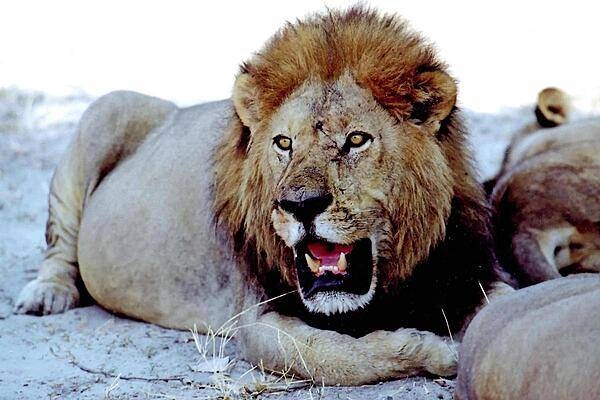180 Botswana

Light blue with a horizontal white-edged black stripe in the center. The blue symbolizes water in the form of rain, while the black and white bands represent racial harmony.
Flag courtesy of the CIA World Factbook

Map courtesy of the CIA World Factbook

A contented male lion following a big meal.
Photo courtesy of the CIA World Factbook
Government
According to Britannica, under the 1966 constitution (since amended), Botswana is a multiparty republic. The president, who serves as the head of state and government, is indirectly elected to a five-year term and limited to 10 years in office. The National Assembly is composed of elected members (elected by universal adult suffrage) and a handful of ex officio members and appointed members nominated by the ruling political party; all members serve five-year terms. The Ntlo ya Dikgosi (House of Chiefs) serves in an advisory role on matters of legislation pertaining to tribal law and custom. It is composed of permanent members (representing each of the eight Tswana “tribes”) and members who are selected to serve a five-year term. Botswana’s judicial system consists of a High Court, a Court of Appeals, and several Magistrate Courts.
Local councils, rural and urban, have been elected since 1969 simultaneously with national parliamentary elections. The power of local councils is limited by the right of the central government to nominate ex officio voting members and by central government appointment of supervisory district commissioners and planning staff.
Civil Aviation Authority of Botswana (CAAB)
The Civil Aviation Authority of Botswana (CAAB) was established by the Civil Aviation Authority Act, 2008 (CAA Act, 2008) which mandates CAAB to promote aviation safety and security and ensure the regular and efficient use and development of Civil Aviation in Botswana. The Authority commenced full operations on 1st April 2009 as a statutory Corporation under the ministry of Transport and Communications (MTC). The Authority was established by the CAA Act of 2008 and continued under the CAA Act of 2011. CAAB is responsible under the Act for regulation of air transport, providing air navigation services, managing airports and advising the government on all aspects of civil aviation. Most of these functions were formerly being handled by the former Department of Civil Aviation (DCA).
Airspace
SkyVector – Google Maps – ADS-B Exchange
ICAO countries publish an Aeronautical Information Publication (AIP). This document is divided into three parts: General (GEN), En Route (ENR) and Aerodromes (AD). ENR 1.4 details the types of airspace classes they chose to adopt from classes A through G.
Drone Regulations
Remotely Piloted Aircraft In Botswana
Civil Aviation (Remotely Piloted Aircraft) Regulations 2024
Advanced Air Mobility (AAM) Regulations & Policies
None found by the author.
However, should you, the reader, happen to stumble across something to the contrary, please email the author at FISHE5CA@erau.edu and you may be mentioned in the ACKNOWLEDGEMENTS section of this book by way of thanks for contributing to this free eBook!
Advanced Air Mobility (AAM) News
2025
Video courtesy of Advanced Air Mobility Institute from the January 2025 Global AAM Forum. Complete session for Day 1 of this Forum is available on the Advanced Air Mobility Institute YouTube Channel
Short Essay Questions
Scenario-Based Question
You have been hired by a Drone Startup Company. Your boss has immediately assigned this job to you.
They need you to prepare a one-page memo detailing the legalities of using a drone to film lions in Botswana, pictured above.
They need you to mention any national laws and local ordinances.
They specifically want to know what airspace (insert pictures) you will be operating in and whether or not you need an airspace authorization.
Does it matter whether or not you are a citizen of the country?
Lastly, there is a bonus for you if, as you scroll through this chapter, you find any typos or broken links!
Short Essay Questions
- What are the drone categories?
- How is registration addressed?
- How is remote ID addressed?
- What are the model aircraft rules?
- What are the commercial drone rules?
- Are there waivers or exemptions to the rules? If so, for what?
- Would you share a link to an interactive airspace map?
- How is BVLOS addressed?
- How can you fly drones at night?
- How can you fly drones over people?
- Where do you find drone NOTAMs?
- What are the rules for drone maintenance?
- What are the rules for an SMS program?
- What are some unique rules not mentioned above?
- What are the C-UAS rules?
- What are the AAM rules?

